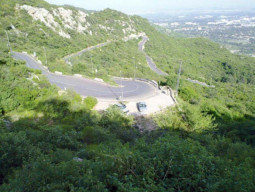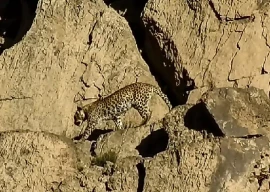
A leopard pauses to take a cautious look around before continuing its way through thick forest in the Margalla Hills overlooking Islamabad - once a rare sight, but now one recorded and tracked by software and cameras.
The cat, once found all over Pakistan but increasingly endangered as humans encroach on their habitat, has been recorded painstakingly by the 20 camera traps attached to trees throughout the forested hills that are also popular with hikers.
"They are being seen on our cameras every day," said Asad Hyat, chief forest guard for the Islamabad Wildlife Management Board (IWMB).
Software identifying the leopards' distinctive rosette patterns has shown seven of the big cats are in the area, which rangers say is a good sign after a significant decline in their numbers over the past few decades.
Great news: today PM Imran Khan directed that a special zone in the Margallah Hills be declared as a leopard preservation zone. He also approved establishment of Wildlife Information Center at Islamabad’s old Marghazar Zoo! @WildlifeBoard pic.twitter.com/oBa1um0XK5
— Rina S Khan Satti (@rinasaeed) October 13, 2021
"They are not so common anymore, because they are being killed mercilessly," said IWMB Chair Rina Khan Satti.
"They were once found all over Pakistan, in almost all the provinces, and now the numbers are declining very fast because of loss of habitat, because of poaching, because of people hunting them for their skin, for their trophies."
It never fails. We submitted a paper saying that macaques are the least preferred prey of leopards in our study area, and then we get this camera trap photo of a leopard dragging a rhesus macaque. pic.twitter.com/edhRLdRInp
— Max Allen (@CarnivoreLab) October 11, 2021
To help the cats, Prime Minister Imran Khan on Wednesday ordered a leopard preservation zone with a roughly 10 km (6.2 miles) radius be set up at Margalla Hills in an effort to protect the endangered species' natural habitat.
مارگلہ ہل نیشنل پارک میں مقامی 'لیپرڈ ریسور ایریا' بنانے کا فیصلہ
— APP 🇵🇰 (@appcsocialmedia) October 14, 2021
وزیراعظم کے معاون خصوصی ملک امین اسلم کی پریس کانفرنس#APPNews @aminattock @MoIB_Official @ClimateChangePK pic.twitter.com/8sTnpFvr93
In recent years, there have been signs of a leopard comeback in the park located just outside of Islamabad.
Conservationists say the animals likely drifted to the Margalla area - foothills of the Himalaya mountains - as it became heavily forested over the years. And they stayed on because they found prey, a stable environment and an eco-system that could support them.
Read more: WATCH: Rare Persian leopard pair sighted in Balochistan
Wildlife rangers check paw tracks on the forest soil daily to monitor the leopards' movements and numbers carefully. They use the footage from their cameras to record their activity.
"This is just the beginning of our scientific study, it will take time," said Satti.
News of the leopards has slowly spread and the IWMB says it is hoping to conduct tours to show the footprints and signs of the leopards in the wild to curious visitors.




1731916090-0/sabrina-(3)1731916090-0-165x106.webp)















COMMENTS (14)
Comments are moderated and generally will be posted if they are on-topic and not abusive.
For more information, please see our Comments FAQ